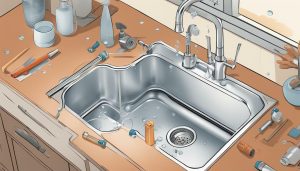If you’re an avid home cook or chef, you know that having sharp knives is crucial for efficient meal preparation and safety in the kitchen. But achieving razor-sharp edges on your kitchen knives takes more than just a quick pass through a knife sharpener. In this article, we’ll cover the best knife sharpening techniques and tips for maintaining sharp kitchen knives to perfection.
Key Takeaways:
- Regular maintenance is crucial for keeping kitchen knives sharp.
- Proper knife sharpening requires the use of specific tools and techniques.
- Understanding the difference between honing and sharpening is important for maintaining knife sharpness.
- Professional knife sharpening services can provide optimal results.
- Following safety precautions is crucial when sharpening knives at home.
Understanding Knife Sharpening
Knife sharpening is the process of removing dull metal from a knife’s blade to create a sharp edge. There are several knife sharpening techniques used by professional chefs and home cooks to maintain sharp kitchen knives, including honing and sharpening.
Honing is the process of realigning the edge of the blade. It involves using a honing rod to smooth out any bends or misalignments in the blade, resulting in a sharper edge. Honing should be done regularly to maintain the sharpness of the knife. However, honing cannot restore a dull blade.
Sharpening, on the other hand, is the process of removing metal from the blade to create a new sharp edge. It involves using sharpening stones or other sharpening devices to grind away metal and create a sharp edge. Sharpening should be done only when the knife is dull, as over-sharpening can damage the blade.
Maintaining sharp kitchen knives requires regular maintenance and sharpening. Professional knife sharpening methods involve using high-quality sharpening tools and techniques to restore the sharpness and edge of the knives. Home cooks can learn effective knife sharpening techniques and maintain their kitchen knives with regular honing and sharpening.
Essential Tools for Knife Sharpening
Proper knife sharpening at home requires essential tools that you need to secure first before you start. These tools include sharpening stones, honing rods, and knife sharpeners.
Sharpening stones are the most traditional and affordable option for knife sharpening at home. They come in different grit sizes and materials like natural stones, synthetic stones, or diamond stones. Generally, the coarser the stone, the more metal it removes from the knife, while the fine stones give them a polished edge.
Honing rods, or sharpening steels, are often used in between sharpening to preserve the sharpness of the blade. They work by straightening the blade’s edge, aligning the microscopic teeth that make the blade sharp. They come in different materials, including ceramic, diamond, or steel.
Electric knife sharpeners are an easy-to-use option that takes the manual labor out of knife sharpening. They have built-in angle guides and sharpening stages to ensure consistent and effective knife sharpening.
Types of Knife Sharpeners
| Knife Sharpener Type | Pros | Cons |
|---|---|---|
| Pull-Through Sharpener | Easy to use and affordable | Can cause excessive material removal and leave a rough edge |
| Manual Sharpening Systems | More precise than pull-through sharpeners | Can be time-consuming and require some skill |
| Electric Sharpeners | Fast and efficient, with consistent results | May remove more material than necessary, leading to a shorter blade lifespan |
When selecting a knife sharpener, consider the types of knives you own, what kind of materials are best for sharpening them, and the level of precision you desire.
These tools are essential for effective knife sharpening at home. Remember to use them safely and follow their instructions carefully to achieve optimal results.
Preparing Your Knives for Sharpening
Before you start sharpening your kitchen knives, it’s essential to prepare them correctly. This step is crucial in maintaining sharp kitchen knives. First, ensure your knives are clean from any food debris or dirt that may have accumulated on them. For this, you can use a damp cloth or soapy water to clean the blades. Avoid using abrasive cleaners or steel wool as they can damage the blade surface.
Next, inspect the blades to identify any signs of damage or wear and tear. Check for chips, cracks, or rust that may affect the quality of the sharpening process. It’s crucial to address any damages before sharpening your knives.
Lastly, ensure the knives are dry before sharpening them. Water can cause corrosion and lead to rusty blades. Use a clean cloth to wipe the knives and leave them to air dry for a few minutes. This ensures that you have the best possible starting point for effective knife sharpening at home.
Step-by-Step Knife Sharpening Technique
Sharpening your kitchen knives to perfection is essential for efficient cooking and meal preparation. Here is a step-by-step guide to help you sharpen your knives like a pro:
- Choose your sharpening tool: There are different types of sharpening tools, including sharpening stones, honing rods, and electric sharpeners. Select the tool that you are most comfortable using.
- Prepare your sharpening tool: If you are using sharpening stones, soak them in water for the recommended amount of time. If you are using an electric sharpener, make sure it is plugged in and ready to use.
- Clean and inspect your knife: Before sharpening, clean your knife with warm soap and water then dry it off. Inspect the blade for any visible nicks or chips.
- Hold the knife correctly: Secure the handle with your dominant hand and use your other hand to hold the knife near the blade edge. Make sure you have a firm grip on the knife.
- Sharpen the blade: If you are using a sharpening stone, hold the blade at a 20-degree angle and apply light pressure while moving it across the stone. Repeat the process on both sides of the blade until you have achieved the desired sharpness. If you are using an electric sharpener, follow the manufacturer’s instructions.
- Hone the blade: After sharpening, use a honing rod to straighten the blade and refine the sharpness. Hold the honing rod vertically and swipe the blade against it in a downward diagonal motion. Repeat the process on both sides of the blade.
- Test the sharpness: To test if your knife is sharp enough, try slicing through a piece of paper. A sharp knife should be able to glide through the paper with ease.
Remember to always work with sharp knives for efficient and safe kitchen preparation. Regularly sharpen and maintain your kitchen knives to ensure they remain in optimal condition.
Honing vs. Sharpening: Understanding the Difference
Before we dive into the nitty-gritty of knife sharpening techniques, it’s important to understand the difference between honing and sharpening. While the two terms are often used interchangeably, they actually refer to distinct processes that serve different purposes.
Sharpening is the process of removing material from the blade to create a new, sharp edge. This is typically done using a sharpening stone or an electric sharpener. Honing, on the other hand, is the process of realigning the edge of the blade to maintain its sharpness. This is done using a honing rod, which simply straightens out the edge of the blade without removing any material.
So, when should you sharpen your knives versus honing them? Generally speaking, you should sharpen your knives when the blade is dull or damaged, and honing should be done regularly to maintain sharpness between sharpenings. Think of honing as a maintenance task that keeps your knives in top condition, while sharpening is more of a repair job that is necessary when the blade has been worn down or damaged.
Tips for Maintaining Razor-Sharp Knives
To keep your kitchen knives sharp and efficient, it’s essential to maintain them regularly. Here are some additional tips and hacks for maintaining razor-sharp knives:
- Store knives properly: Keep your knives in a knife block, on a magnetic strip, or in a protective sheath to prevent the blades from getting dull from contact with other objects.
- Regular honing: Use a honing rod to maintain knife sharpness between sharpenings. Honing realigns the blade’s edge, keeping it sharp.
- Avoid dishwasher: Hand-wash knives and dry them thoroughly to avoid exposure to the harsh chemicals and extreme heat that can damage the blade’s edge.
- Cut on proper surfaces: Cutting boards made of wood, bamboo, or plastic are gentle on knife blades. Avoid cutting on hard surfaces such as stone or glass that can dull the blade quickly.
- Proper knife usage: Use your knives for their intended purposes. For example, use a chef’s knife for slicing and dicing meats and vegetables, and reserve serrated knives for bread and other baked goods.
- Avoid bone contact: Do not use a kitchen knife to cut through bones as it can damage the blade. Use a separate bone saw instead.
- Clean and dry after each use: Clean your knives thoroughly after each use and dry them immediately. Do not leave them soaking in water or wet for a long time.
- Avoid twisting motions: Avoid twisting the knife while cutting as it can damage the blade and make it dull.
- Regular maintenance: Get your knives professionally sharpened or sharpen them at home regularly to keep them in optimal condition.
By following these tips, you can extend the sharpness of your kitchen knives and improve their performance in the kitchen.
Professional Knife Sharpening Services
While sharpening knives at home can be effective, there are times when professional knife sharpening services may be necessary. Professional sharpeners have the knowledge and equipment to sharpen knives to a precise edge, extending their lifespan and maintaining optimal performance.
When choosing a professional knife sharpening service, make sure to research their reputation and experience. Look for reviews and testimonials from previous customers and ask about their sharpening process. A reputable service will be happy to answer your questions and provide you with information about their techniques and methods.
It’s important to note that while professional sharpening is highly effective, it may not be necessary on a regular basis. If you take good care of your knives and sharpen them regularly at home, you may only need professional sharpening once a year or less.
Ultimately, the decision to use professional knife sharpening services depends on your individual needs and preferences. If you’re unsure whether professional sharpening is right for you, consider asking for advice from a trusted kitchen supply store or professional chef.
Tips for Knife Sharpening at Home
Sharpening your kitchen knives at home can be a cost-effective and convenient solution to maintain their sharpness. However, it’s important to take safety precautions and use effective techniques to avoid damaging the blades or injuring yourself.
Safety Precautions
Before beginning the sharpening process, it’s crucial to take safety precautions to protect yourself from accidents and injuries. Here are some essential tips to follow:
- Wear protective gloves to prevent injuries from the sharp blades.
- Work on a stable surface to avoid slipping or losing control of the knife.
- Keep your hands away from the blade’s edge and handle it with care to avoid cuts.
- Use proper grip when holding the knife to avoid slipping or damaging the blade.
Effective Knife Sharpening Techniques
There are different techniques to sharpen kitchen knives at home. Here are some of the most effective ones:
- Using sharpening stones: Start with a coarse grit stone to remove any nicks or damages and then move to a finer grit stone to hone the edge.
- Using honing rods: Use a honing rod to straighten the blade’s edge and realign it for a sharper edge.
- Using electric knife sharpeners: These devices are easy to use and can provide precise sharpening results.
Regardless of the technique used, make sure to follow the manufacturer’s instructions and use the correct angle and pressure to avoid damaging the blade or creating an uneven edge.
By following these tips and techniques, you can effectively sharpen your kitchen knives at home, maintaining their sharpness and ensuring optimal performance.
Tips for Extending Knife Sharpness
Maintaining sharp kitchen knives is essential for optimal performance in the kitchen. To help you extend the sharpness of your knives between sharpenings, here are some of the best knife sharpening tips:
- Use a cutting board made of materials such as wood, bamboo, or plastic. Avoid cutting on hard surfaces such as glass or stone, as they can quickly dull your knives.
- Avoid using your kitchen knives for tasks they weren’t designed for, such as prying open cans or bottles. Use specialty tools instead to avoid damaging the blade.
- Regularly clean your knives with warm, soapy water and dry them thoroughly. This prevents corrosion and rust that can lead to dullness.
- Store your knives in a safe and secure location. Using knife blocks or magnetic knife strips is an excellent option as it keeps your knives organized and easily accessible.
- Sharpen your knives regularly. Honing your knives every few uses with a honing rod can help maintain their sharpness and avoid the need for frequent sharpening.
- Finally, consider investing in high-quality knives that are designed to last. While they may be more expensive, they are often worth the investment in the long run.
By following these tips, you can achieve optimal sharpness and performance of your kitchen knives, reducing the time, effort, and frustration associated with using dull blades.
Conclusion
Keeping your kitchen knives sharp is essential for efficient cooking and meal preparation. Whether you choose to sharpen your knives at home or opt for professional services, regular maintenance is key to maintaining their sharpness.
Throughout this article, we’ve explored the basics of knife sharpening, essential tools required, preparing your knives for sharpening, and step-by-step techniques to sharpen your knives. We’ve also covered the difference between honing and sharpening, offered tips on maintaining razor-sharp knives, the benefits of professional sharpening services, and important safety precautions to follow while sharpening knives at home.
By following these tips and techniques, you can extend the sharpness of your knives and ensure efficient cooking and meal preparation. Remember to always handle sharp knives with care and maintain their sharpness to avoid accidents and ensure optimal performance.
FAQ
Q: How often should I sharpen my kitchen knives?
A: It depends on how frequently you use your knives, but a general rule of thumb is to sharpen them every 3-6 months.
Q: What is the difference between honing and sharpening?
A: Honing is a technique used to maintain knife sharpness between sharpenings, while sharpening involves removing metal to restore a dull blade.
Q: Can I sharpen my knives at home?
A: Yes, you can sharpen your knives at home using sharpening stones, honing rods, or electric sharpeners.
Q: What tools do I need for knife sharpening at home?
A: You will need sharpening stones, honing rods, or an electric sharpener, along with a cleaning cloth and lubricating oil.
Q: How do I prepare my knives for sharpening?
A: Before sharpening, clean and inspect the blades to ensure they are free from debris or damage.
Q: What is the best angle to sharpen kitchen knives?
A: The optimal angle for sharpening kitchen knives is usually between 15 to 20 degrees.
Q: How can I maintain the sharpness of my knives?
A: Regular honing, proper storage, and using the correct cutting surfaces can help maintain the sharpness of your knives.
Q: Are there professional knife sharpening services available?
A: Yes, there are professional knife sharpening services that can restore your knives to optimal sharpness.
Q: What safety precautions should I take while sharpening knives at home?
A: It is important to use protective gloves, maintain a stable work surface, and handle sharp blades with care to prevent accidents.
Q: How can I extend the sharpness of my kitchen knives?
A: By using proper cutting techniques, avoiding hard surfaces, and regularly cleaning and maintaining your knives, you can extend their sharpness.

It’s me, Amber Hayden, the heart and soul behind SagarmathaOnlineMedia.com. From a young age, I’ve been head over heels for everything home-related, from interior decor to gardening. I’m the type who can’t resist a well-crafted piece of furniture, and I firmly believe that a home isn’t complete without a pet or two. But it’s not just about creating pretty spaces for me. I’m all about making homes that tell a story reflecting the people living there. SagarmathaOnlineMedia.com is my way of sharing this passion with you. Whether you’re looking for tips to jazz up your living room, advice on pet care, or ideas to make your garden bloom, I’m here to help. So, let’s embark on this journey together and make your house a home!



